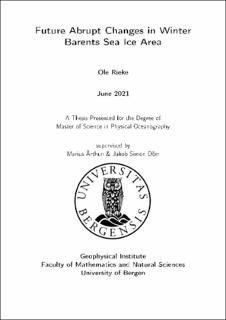Future Abrupt Changes in Winter Barents Sea Ice Area
Master thesis
Permanent lenke
https://hdl.handle.net/11250/2762637Utgivelsesdato
2021-06-01Metadata
Vis full innførselSamlinger
- Master theses [118]
Sammendrag
The Barents Sea is an area of strong anthropogenic winter sea ice loss that is superimposed by pronounced internal variability on interannual to multidecadal timescales. This internal variability represents a source of large uncertainty in future climate projections in the Barents Sea. This study aims to investigate internal variability of Barents Sea ice area and its driving mechanisms in future climate simulations of the Community Earth System Model Large Ensemble under the RCP8.5 climate scenario. We find that although sea ice area is projected to decline towards ice-free conditions, internal variability remains strong until late in the 21st century. A substantial part of this variability is expressed as events of abrupt change in the sea ice cover. These internally-driven events with a duration of 5-9 years can mask or enhance the anthropogenically-forced sea ice trend and lead to substantial ice growth or ice loss. Abrupt sea ice trends are a common feature of the Barents Sea in the future until the region becomes close to ice-free. Interannual variability in general, and in form of these sub-decadal events specifically, is forced by a combination of ocean heat transport, meridional winds and ice import, with ocean heat transport as the most dominant contributor. Our analysis shows that the influence of these mechanisms remains largely unchanged throughout the simulation. Investigation of a simulation from the same model where global warming is limited to 2°C shows that both mean and variability of sea ice area in the Barents Sea can be sustained at a substantial level in the future, and that abrupt changes can continue to occur frequently and produce sea ice cover of similar extent to present day climate. This highlights that future emissions play an essential role in the further decline of the Barents Sea winter sea ice cover. The results of this thesis contribute to a better understanding of Arctic sea ice variability on different time scales, and especially on the role of internal variability which is important in order to predict future sea ice changes under anthropogenic warming.
